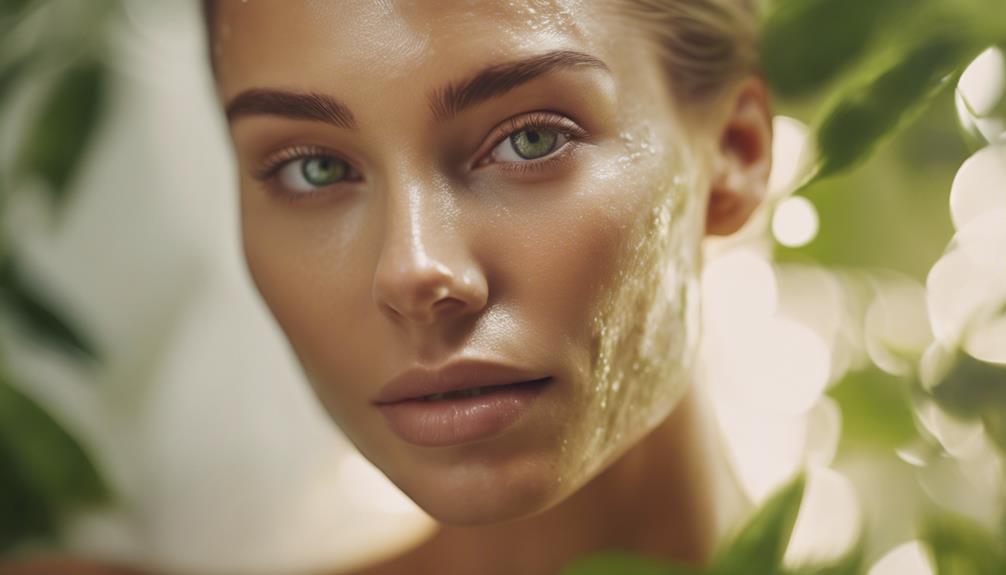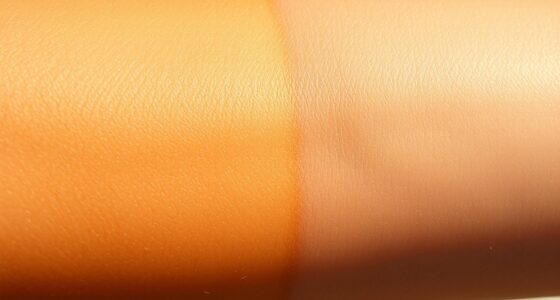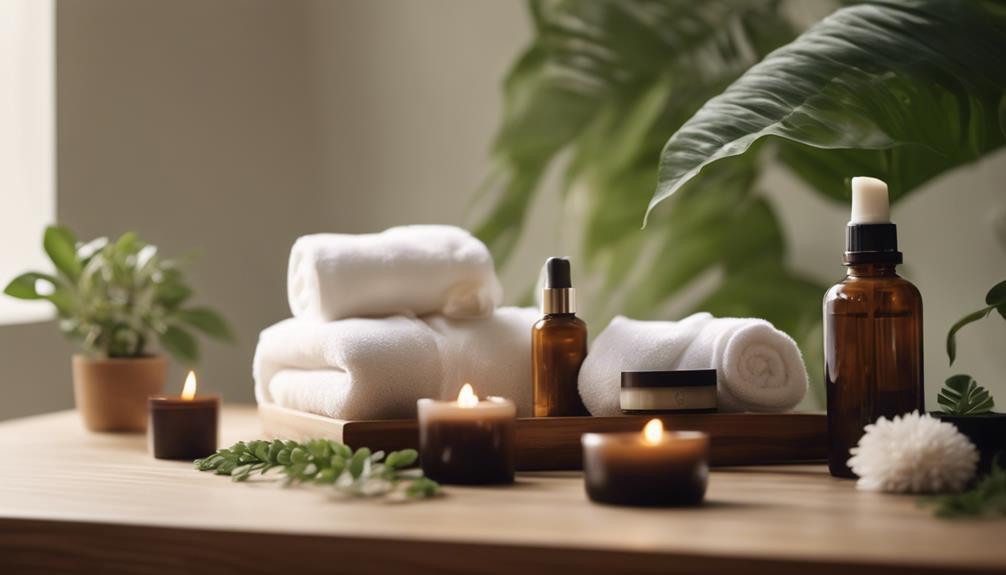Your skin has an expiration date, influenced by age, sun damage, and pollution. After 30, cell renewal slows, leading to dryness and dullness. You can reset the clock by incorporating antioxidants like Vitamin C, hydrating with hyaluronic acid, and using retinoids to boost cell turnover. Regularly check your products for expiration and discard anything that's past its prime, as expired products can cause irritation and reduce efficacy. Adjust your skincare routine seasonally to combat environmental changes. Explore effective strategies for maintaining youthful skin and protecting its integrity for a radiant complexion. There's more to discover about revitalizing your skincare game.
Key Takeaways
- Regularly assess and discard expired skincare products to prevent irritation and ensure effectiveness.
- Incorporate antioxidants, hyaluronic acid, and peptides into your routine to combat aging signs and enhance skin health.
- Adjust your skincare regimen seasonally to address hydration needs and prevent dryness or oiliness.
- Maintain a consistent routine of cleansing, moisturizing, and sun protection to support skin longevity.
The Hidden Truth About Aging
Aging isn't just a number; it's a complex process influenced by everything from environmental factors to lifestyle choices that can dramatically affect your skin's health.
One of the biggest culprits of accelerated aging is sun damage. UV exposure leads to a breakdown of collagen and elastin, essential proteins that keep your skin firm and youthful. By the time you hit 30, your skin cells start regenerating more slowly, making it easier for signs of aging to creep in.
Pollution and free radicals from the environment also play significant roles in aging. They create oxidative stress, which damages skin cells and contributes to that dull, tired look.
If you want to maintain your natural skin's vibrancy, you need to take action. Incorporating antioxidants into your skincare routine can help combat this damage, while regular hydration keeps your skin plump and elastic.
Don't forget the importance of sun protection. Wearing broad-spectrum sunscreen daily helps shield your skin from harmful UV rays, slowing down the aging process.
Signs Your Skin Is Expiring

You might notice visible changes in your skin, like increased dryness or breakouts, which can signal that your products aren't working as they should.
If your skin feels more sensitive or reacts with redness after using certain products, it's a sign they may no longer be suitable for you.
Keeping an eye on these indicators can help you reset your skincare routine effectively.
Visible Skin Changes
Visible skin changes like increased roughness or a dull complexion often signal that it's time to reassess your skincare products and routine. If you notice flaky patches or an uneven skin tone, it could mean the active ingredients in your products have degraded. You might also face increased breakouts or persistent dryness, indicating that your skincare products are no longer effective.
Here's a quick reference to help identify visible skin changes:
| Visible Change | Possible Cause | Action Needed |
|---|---|---|
| Increased Roughness | Expired or ineffective products | Switch to good quality alternatives |
| Dull Complexion | Degraded active ingredients | Reevaluate and refresh your routine |
| Loss of Elasticity | Inactive ingredients in current products | Incorporate new active formulations |
Don't ignore these signs; they're your skin's way of telling you it needs a reset. By addressing these visible skin changes, you can restore your skin's liveliness and guarantee your skincare products are working as they should.
Increased Sensitivity Reactions
Increased sensitivity reactions, such as redness and itching, often signal that skincare products have expired or become ineffective. If you notice these symptoms, it's vital to assess the products you're using. Expired products can cause your skin to feel irritated and may even lead to burning sensations. Changes in texture, like dryness or flakiness, indicate that your skincare isn't providing adequate hydration or nutrition anymore.
You should also be on the lookout for unusual blemishes or breakouts, as these could mean expired products are harboring bacteria, exacerbating your sensitivity. Make sure to inspect your skincare items regularly; any unpleasant odors or noticeable changes in color or consistency often mean they've degraded.
Regular patch testing of new products is essential, especially if your skin has recently become more sensitive. Always check the ingredients to see if they contain anything that could potentially irritate your skin further.
Calculate Your Skin's Lifespan

Calculating your skin's lifespan involves understanding its natural renewal cycle and how various factors can influence its health and appearance. Typically, your skin renews itself every 28 days, but as you age, this process might slow down, leading to a longer turnover time. This means that you could find your skin looking less vibrant over time if you don't take care of it.
Here are a few key factors to evaluate:
- Sun exposure: UV rays can accelerate skin aging, so protect yourself!
- Pollution: Environmental stressors can harm your skin's health; be mindful of your surroundings.
To keep your skin looking fresh, think about using a gentle exfoliant to promote cell turnover and reveal brighter skin.
Additionally, monitor the effectiveness and expiration of your skincare products, as outdated items can hinder your skin's health.
Essential Steps to Reset

Resetting your skin starts with evaluating your current skincare products and routines to identify what needs to be changed or removed. Regularly check expiration dates and PAO symbols to verify your products are still effective. Declutter your collection by removing items that don't spark joy or show signs of degradation, such as bad odors or unusual textures.
Next, simplify your routine. Focus on a basic regimen of cleansing and hydration to allow your skin to recover and pinpoint any issues caused by product overload. Once you've established a minimalist routine, gradually introduce new products, verifying you patch test to monitor any reactions.
Lastly, maintain consistent storage practices. Keep your products in cool, dark places to prolong their effectiveness.
Here's a quick reference table to guide you:
| Step | Action |
|---|---|
| Check Expiration Dates | Regularly review products for safety |
| Declutter | Remove ineffective or degraded items |
| Simplify Routine | Focus on cleansing and hydration |
| Patch Test New Products | Gradually introduce and monitor reactions |
Impact of Expired Products

Using expired skincare products can leave your skin unprotected and less effective in addressing your needs.
Not only do these products lose potency, but they can also harbor harmful bacteria, increasing the risk of irritation or infection.
Regularly checking your products guarantees that you're using safe and effective skincare.
Product Ineffectiveness Over Time
Expired skincare products lose their potency, which can leave your skin vulnerable to irritation and ineffective treatments. When you use products past their expiration date, active ingredients may become inactive, resulting in diminished benefits from your routine.
It's essential to regularly check expiry dates and PAO symbols, especially for items like eye creams that often have a short shelf life of about three months.
To help you stay on top of this, consider the following tips:
- Check for signs of degradation: If a product smells off, has changed color, or feels different in consistency, it's time to toss it.
- Organize your skincare inventory: Keep your products in a way that prioritizes newer items for use first, minimizing waste.
Safety Risks of Expiration
Neglecting to check expiration dates can expose your skin to safety risks, as expired products may lead to irritation or adverse reactions.
When you use expired skincare, the active ingredients can lose their potency, making them ineffective in delivering the benefits you expect. Over time, some ingredients may even become harmful, causing redness, rashes, or other unwanted skin issues.
Additionally, modern skincare often contains fewer preservatives, which means that expired products are more susceptible to bacterial growth. Using such products can introduce harmful bacteria to your skin, increasing the risk of infections.
You should also be vigilant for signs of product degradation, like changes in consistency, color, or smell. These changes are clear indicators that a product is no longer safe to use.
Regularly checking expiration dates and discarding expired products is essential for maintaining healthy skin and preventing potential negative reactions. By prioritizing fresh, effective skincare, you protect not only the integrity of your skin but also its overall health.
Seasonal Changes and Skin Care

Seasonal changes can drastically impact your skin's hydration, making it essential to adapt your skincare routine to meet its evolving needs.
During winter, lower humidity and harsh weather can lead to dryness. To combat this, switch to thicker creams and richer moisturizers that lock in moisture.
On the flip side, summer calls for lightweight, non-comedogenic products that won't clog your pores.
Here are a few tips to keep your skin healthy throughout the seasons:
- Reassess your routine: Regularly check in with your skincare products as the seasons change to address issues like dryness or oiliness.
- Hydrate internally: Drinking plenty of water year-round is vital for maintaining your skin's moisture levels.
Must-Have Ingredients for Youthful Skin

To achieve youthful skin, you'll want to incorporate must-have ingredients that nourish, protect, and rejuvenate your complexion.
Start with antioxidants like Vitamin C and E; they combat free radicals, reducing signs of aging and enhancing your overall appearance.
Next, include hyaluronic acid in your routine. This powerful humectant can hold up to 1,000 times its weight in water, keeping your skin hydrated and plumping fine lines and wrinkles.
Don't overlook peptides, either. These essential building blocks of skin proteins stimulate collagen production, improving firmness and elasticity.
For texture and cell turnover, retinoids derived from Vitamin A are a must. They're clinically proven to enhance skin smoothness and reduce fine lines, giving you a youthful glow.
How to Evaluate Your Products

Evaluating your skincare products is just as important as choosing the right ingredients for maintaining youthful skin. Regular checks can help guarantee that your products remain effective and safe to use.
Start by looking for expiry dates and PAO (Period After Opening) symbols on your products. If you notice any changes in consistency, smell, or color, it's time to toss those items out.
To streamline your skincare routine, consider these tips:
- Declutter: Remove products that don't spark joy or that you haven't used in a while. This helps you focus on what truly works for your skin.
- Prioritize: Use products with active ingredients before their expiry dates. Their potency can fade over time, making them less effective.
The Cost of Neglecting Skin Care

Neglecting your skincare can lead to significant long-term consequences, including premature aging and costly treatments for skin conditions.
Studies show that poor skincare routines can make visible signs of aging appear up to 10 years earlier than those who consistently care for their skin. Without proper cleansing and moisturization, you risk developing issues like dryness, irritation, and breakouts, which can worsen over time if ignored.
The financial implications of neglect can escalate quickly. Treating conditions like acne or eczema often requires expensive dermatologist visits and prescription medications. Additionally, skipping sun protection can result in severe long-term damage, including an increased risk of skin cancer and hyperpigmentation. Just one severe sunburn can double your risk of melanoma.
Using expired products compounds these issues, as they can lead to allergic reactions, infections, and diminished effectiveness of active ingredients.
In the end, neglecting your skincare routine not only shortens the lifespan of your skin but also forces you to spend more on repairs and treatments. Taking the time to invest in your skincare today can save you both time and money in the future.
Strategies for Long-Term Skin Health

Taking proactive steps in your skincare routine can markedly enhance your skin's health and longevity.
Start by regularly checking your skincare products for expiration dates and signs of spoilage. Using expired products can lead to irritation and reduce effectiveness. A consistent skincare routine is vital, so make sure you cleanse, moisturize, and protect your skin from the sun daily.
Incorporate omega-rich foods into your diet, such as fish oil, flaxseed oil, and avocados. These foods can help enhance skin hydration and elasticity, supporting long-term skin health.
Staying informed about product ingredients is equally important. Opt for fragrance-free and hypoallergenic options to minimize the risk of irritation, especially if you have sensitive skin.
Don't forget to practice self-care and stress management techniques. Your overall well-being plays a significant role in the health and appearance of your skin.
By prioritizing these strategies, you'll not only reset the clock on your skin's expiration date, but you'll also cultivate a radiant complexion for years to come.
Frequently Asked Questions
How Long Can You Use Skincare After the Expiration Date?
You shouldn't use skincare products after their expiration date. While some may seem fine, the active ingredients can degrade, leading to irritation or infections. Always check for changes in consistency, color, or smell before use.
How to Read Expiration Dates on Skin Care?
Ever wondered if your skincare's still safe? To read expiration dates, look for the jar icon with a number and ‘M'. Trust your instincts—discard products showing signs of spoilage, even if the date hasn't passed.
Is It Safe to Use Unopened Expired Skin Care Products?
You shouldn't use unopened expired skincare products. While they might seem safe, their effectiveness can diminish, and using them could lead to adverse reactions. Always check for changes in color, consistency, or odor before applying.
How to Know if Skin Toner Is Expired?
To know if your skin toner's expired, check the expiration date, observe any changes in consistency or smell, and watch for irritation. Store it properly to help maintain its quality and effectiveness.
What Are the Best Ways to Reset Your Skin’s Clock and Wake It Up from Hibernation Mode?
During the winter season, our skin tends to go into hibernation mode, leading to dullness and dryness. To reset your winter skin hibernation mode, try exfoliating regularly, using hydrating creams, and drinking plenty of water. Adding a retinol serum to your skincare routine can also help wake up your skin and restore its natural glow.
Conclusion
Just like a garden needs care to flourish, your skin deserves constant attention to thrive.
By understanding its aging process and recognizing the signs of wear, you can reset the clock and rejuvenate your complexion.
Embrace essential ingredients, evaluate your products, and commit to a consistent routine.
Neglecting your skin is like letting weeds take over; tackle them early, and you'll cultivate a vibrant, youthful glow that lasts.
Your skin's future is in your hands—nurture it wisely!









